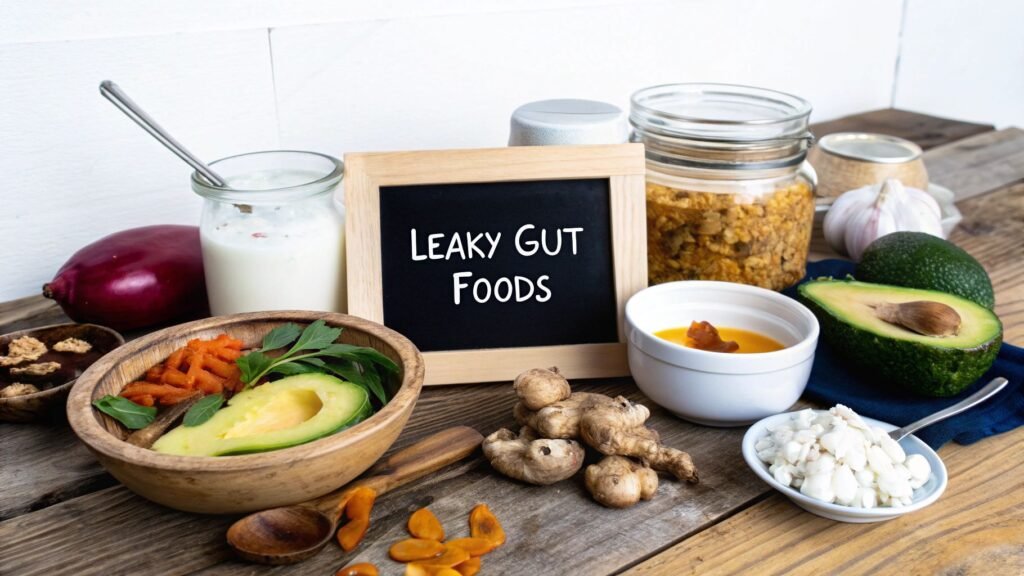Leaky gut, or increased intestinal permeability, is a condition where the intestinal lining becomes compromised, allowing undigested food particles and toxins to enter the bloodstream. This can trigger widespread inflammation and contribute to various health issues, from digestive distress and fatigue to chronic pain. While the concept can seem daunting, the path to healing often begins on your plate. Nutrition is the cornerstone of repairing the gut barrier, reducing inflammation, and rebalancing your microbiome.
This article provides a comprehensive, evidence-based roundup of the best foods for leaky gut, moving beyond generic advice to offer actionable strategies. We'll explore the specific mechanisms behind each food's healing properties, offer practical tips for incorporation, and provide insights drawn from both scientific research and clinical practice. Our goal is to empower you with the knowledge to build a sustainable, gut-healing diet that restores your digestive wellness and overall vitality. For many, a foundational step involves reducing common irritants, and incorporating gluten-free food staples can significantly support gut health by minimizing inflammatory triggers. From the foundational role of bone broth to the probiotic power of fermented vegetables, this is your definitive guide to nourishing your way back to health.
1. Bone Broth
Bone broth is a nutrient-rich liquid created by slowly simmering animal bones and connective tissues for an extended period, typically 12 to 24 hours. This traditional food is revered in gut-healing protocols for its high concentration of restorative compounds, making it one of the best foods for leaky gut. Its power lies in its unique profile of amino acids like glutamine, glycine, and proline, which are the fundamental building blocks for repairing a damaged intestinal lining.
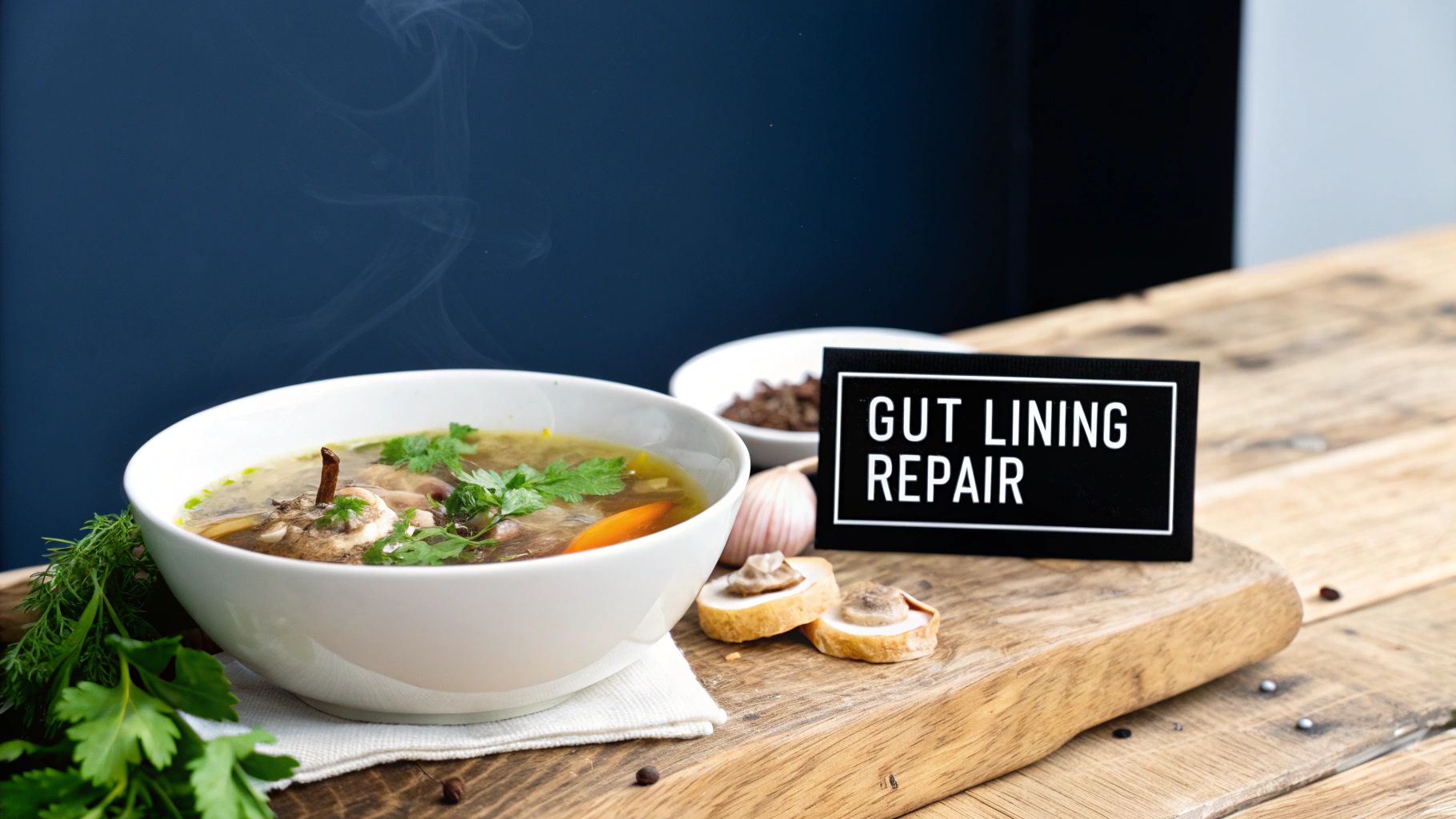
The slow simmering process breaks down collagen from the bones and cartilage into gelatin. This gelatin helps restore the strength and integrity of the gut lining by nourishing the mucosal layer, effectively "sealing" the tight junctions that have become permeable in leaky gut syndrome. This makes bone broth a foundational component in dietary plans like the GAPS diet, Paleo, and Autoimmune Protocol (AIP).
How to Implement Bone Broth for Gut Health
Incorporating bone broth is straightforward and can be adapted to any routine. Start by consuming one cup daily on an empty stomach to maximize absorption. As your system adapts, you can increase this to two or three cups per day.
For maximum benefit, consider these actionable tips:
- Source Quality Bones: Always opt for bones from organic, grass-fed, or pasture-raised animals to avoid exposure to antibiotics and hormones.
- Proper Preparation: Add a splash of apple cider vinegar to the pot before simmering. The acidity helps extract more minerals and collagen from the bones.
- Check for Gelatin: A high-quality bone broth will thicken and gel when refrigerated. This is a visual indicator of a high gelatin content, which is crucial for gut repair.
- Convenient Storage: Freeze homemade broth in ice cube trays or silicone molds for easy, pre-portioned servings you can add to soups, stews, or simply reheat to drink.
Leading functional medicine practitioners like Dr. Josh Axe and Dr. Kellyann Petrucci have popularized its use, and brands like Kettle & Fire and BRODO have made high-quality options widely available. Whether you make it at home or purchase it, consistency is key to leveraging its gut-healing properties.
2. Fermented Vegetables (Sauerkraut, Kimchi)
Fermented vegetables are foods preserved through lacto-fermentation, a process where beneficial bacteria convert natural sugars into lactic acid. This ancient preservation method creates probiotic-rich foods loaded with beneficial bacteria strains like Lactobacillus that help restore healthy gut flora, strengthen the intestinal barrier, and reduce inflammation. As some of the best foods for leaky gut, sauerkraut and kimchi contain billions of live microorganisms per serving, which directly support the integrity of the gut lining.
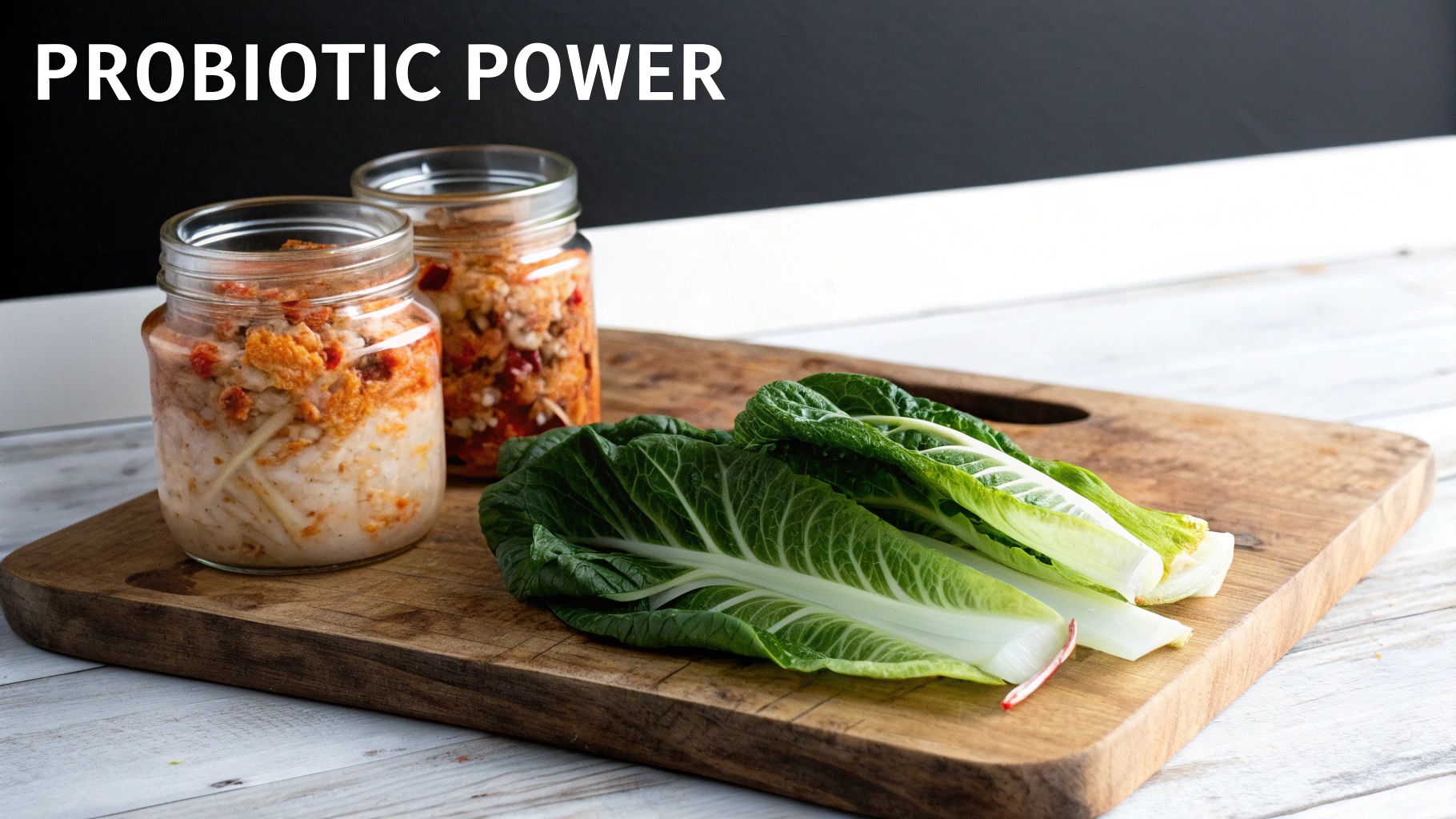
These foods work by introducing diverse probiotic species into the digestive tract, which helps to crowd out pathogenic bacteria and rebalance the gut microbiome. The organic acids produced during fermentation also help maintain an optimal pH in the gut, which supports healthy digestion and nutrient absorption. For this reason, integrative health clinics and functional medicine practitioners often recommend fermented foods as part of gut-healing protocols. You can explore a deeper dive into the best foods for digestive health to understand their broader impact.
How to Implement Fermented Vegetables for Gut Health
Start slowly to allow your gut to adjust to the new influx of beneficial bacteria. Begin with just one or two tablespoons daily with a meal, gradually increasing your intake to 1/4 or 1/2 cup per day as tolerated.
For maximum benefit, consider these actionable tips:
- Choose Unpasteurized: Always select raw, unpasteurized versions from the refrigerated section of your grocery store. Pasteurization (heating) kills the live probiotics.
- Read the Label: Authentic fermented foods should not contain vinegar. True fermentation uses only salt and the vegetables' own juices to create lactic acid.
- Eat With Meals: Consuming fermented vegetables with food can aid in the overall digestion of your meal and help buffer the introduction of probiotics.
- Make Your Own: Homemade sauerkraut or kimchi is cost-effective and allows you to control the ingredients while maximizing bacterial diversity.
Experts like fermentation revivalist Sandor Katz have championed these traditional foods, and brands such as Wildbrine and Farmhouse Culture offer high-quality, widely available options. If you have a severe gut condition like SIBO, introduce these foods cautiously and preferably under the guidance of a healthcare practitioner.
3. Wild-Caught Fatty Fish (Salmon, Sardines, Mackerel)
Wild-caught fatty fish like salmon, sardines, and mackerel are powerhouse sources of omega-3 fatty acids, specifically eicosapentaenoic acid (EPA) and docosahexaenoic acid (DHA). These essential fats possess potent anti-inflammatory properties, making them one of the best foods for leaky gut. Chronic inflammation is a primary driver of increased intestinal permeability, and omega-3s directly counteract this by modulating inflammatory pathways and strengthening the gut barrier.
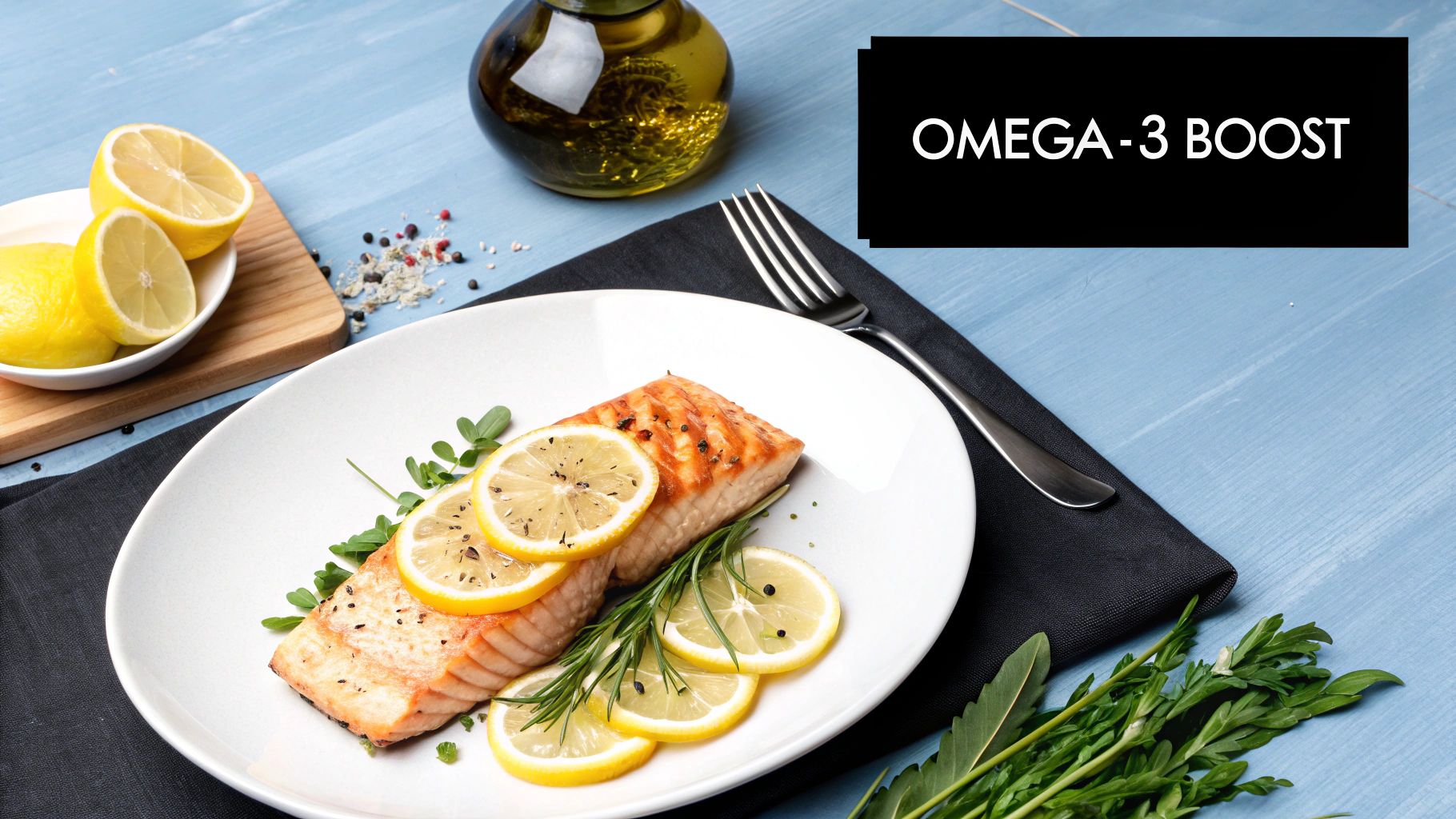
The mechanism involves omega-3s helping to regulate the proteins that form the "tight junctions" between intestinal cells. By reducing the production of inflammatory cytokines that weaken these junctions, these healthy fats help "seal" the gut lining. In addition to their anti-inflammatory role, fatty fish provide high-quality protein and vitamin D, both crucial for the physical repair and regeneration of intestinal cells. Clinical trials have even demonstrated the effectiveness of omega-3s in reducing symptoms of inflammatory bowel conditions. To dive deeper into managing inflammation, you can explore how to reduce inflammation naturally.
How to Implement Fatty Fish for Gut Health
Aim to incorporate fatty fish into your diet two to three times per week, with a serving size of about 4-6 ounces. This consistency provides a steady supply of EPA and DHA to support gut repair and reduce systemic inflammation.
For maximum benefit, consider these actionable tips:
- Choose Wild-Caught: Prioritize wild-caught fish over farm-raised varieties to ensure a higher omega-3 content and avoid potential contaminants like antibiotics.
- Opt for Smaller Fish: Smaller fish like sardines and anchovies are lower on the food chain and thus have a lower mercury content, making them a safer option for frequent consumption.
- Gentle Cooking Methods: Preserve the delicate omega-3 fatty acids by using gentle cooking methods such as baking, poaching, or steaming rather than high-heat frying.
- Convenient and Affordable: Keep canned wild-caught sardines or salmon on hand for a quick, affordable, and nutrient-dense meal. Frozen wild-caught fish is also an excellent, cost-effective option.
Leading experts in integrative and functional medicine, like Dr. Andrew Weil and Dr. Mark Hyman, consistently advocate for including wild-caught fatty fish in a healthy diet. Brands such as Vital Choice and Nordic Naturals have also championed the benefits of high-quality seafood and fish oil supplements for overall wellness.
4. Coconut Products (Coconut Oil, Coconut Milk, Coconut Meat)
Coconut products are a powerhouse for gut restoration due to their unique composition of medium-chain triglycerides (MCTs), including lauric acid, capric acid, and caprylic acid. These healthy fats possess potent antimicrobial, antifungal, and anti-inflammatory properties that help rebalance the gut microbiome. By combating pathogens like harmful bacteria and yeast overgrowth (such as Candida), coconut products reduce the microbial burden that contributes to intestinal hyperpermeability, making them one of the best foods for leaky gut.
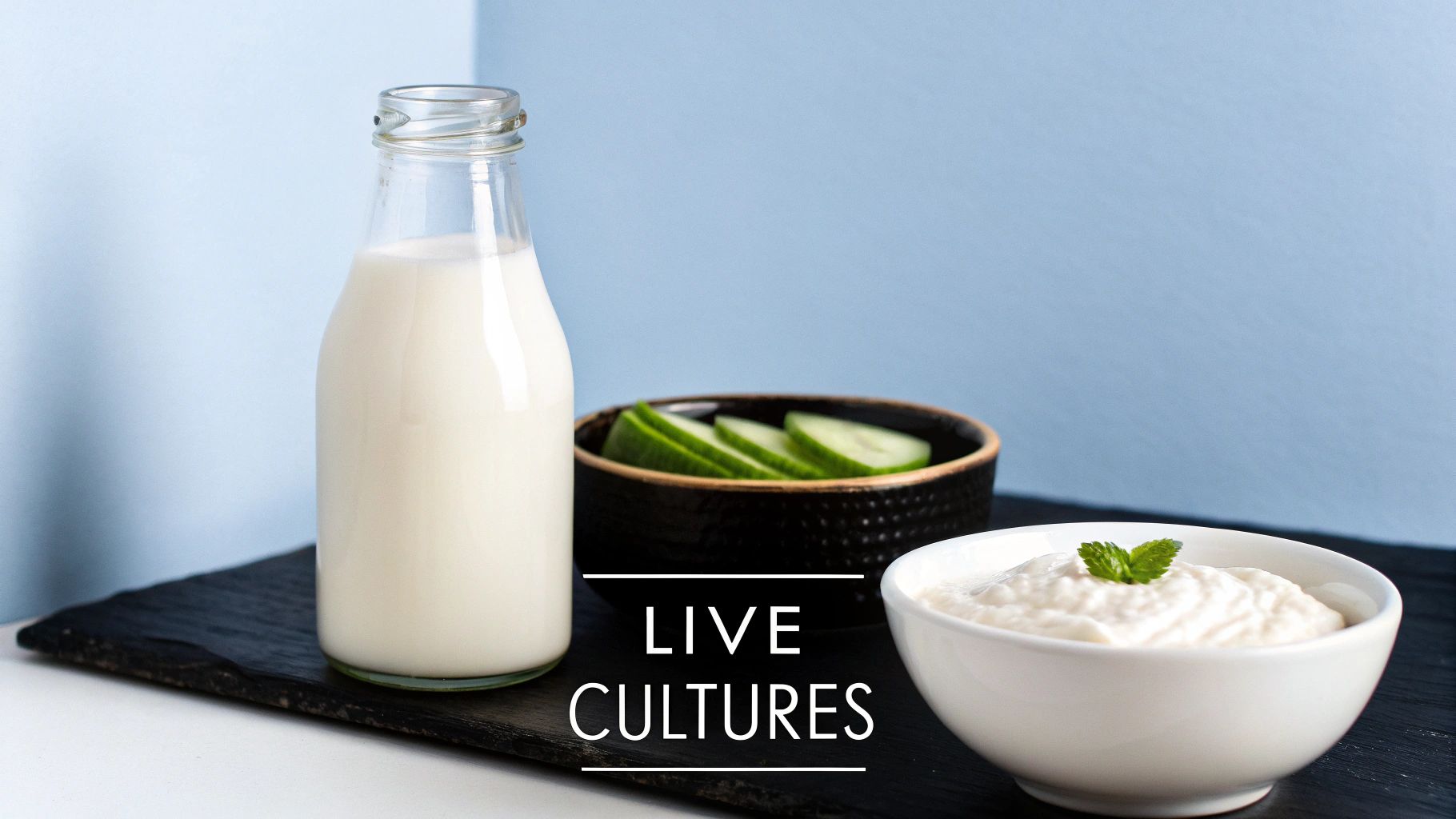
The MCTs in coconut are easily digested and absorbed, providing a quick source of energy that doesn't strain a compromised digestive system. This gentle nature allows the gut to heal without being overworked. For this reason, coconut oil is a cornerstone fat source in healing diets like the GAPS (Gut and Psychology Syndrome) protocol, Candida diet protocols, and the Autoimmune Protocol (AIP), where it's used extensively in cooking and supplementation.
How to Implement Coconut Products for Gut Health
Incorporating coconut products can be simple and versatile. To start, introduce one teaspoon of virgin coconut oil daily, gradually working up to one or two tablespoons as tolerated. This slow approach helps the body adjust to its antimicrobial effects.
For maximum benefit, consider these actionable tips:
- Choose High Quality: Opt for virgin, unrefined, and cold-pressed coconut oil to ensure the highest concentration of beneficial compounds. For coconut milk, select full-fat versions in BPA-free cans without added gums or sweeteners.
- Start Slowly: Begin with a small amount of coconut or MCT oil to avoid digestive upset. Taking it with food can also minimize potential nausea. Be aware that some people may experience "die-off" symptoms like fatigue or headaches initially as harmful microbes are eliminated.
- Use as a Dairy Alternative: Full-fat coconut milk is an excellent dairy-free substitute for milk or cream in smoothies, soups, and curries, providing healthy fats without the inflammatory potential of dairy for sensitive individuals.
- Smart Cooking: Use coconut oil for low-to-medium heat cooking, sautéing, and baking. For a more concentrated antimicrobial effect, consider using pure MCT oil, often added to coffee or smoothies.
Pioneers like Dr. Bruce Fife, author of "The Coconut Oil Miracle," and Dave Asprey, creator of Bulletproof Coffee, have highlighted the benefits of MCTs for overall health. Brands like Nutiva have made high-quality organic coconut products easily accessible, supporting a gut-healing journey.
5. L-Glutamine Rich Foods and Supplementation
L-glutamine is the most abundant amino acid in the bloodstream and serves as the primary fuel source for the cells lining the intestines (enterocytes). It plays a critical role in maintaining the integrity of the intestinal barrier by supporting tight junction proteins and promoting the growth and repair of the mucosal lining. This makes it a cornerstone among the best foods for leaky gut, as it directly nourishes the cells that need to heal.
While the body can produce glutamine, demands often exceed production during times of high stress, illness, or intense physical training. This deficit can impair gut barrier function, making dietary sources and supplementation crucial for healing. Its efficacy is recognized in various protocols; functional medicine experts like Dr. Tom O'Bryan and Dr. Amy Myers universally recommend it for gut repair, and it's even used in clinical settings to protect the gut lining of chemotherapy patients.
How to Implement L-Glutamine for Gut Health
Incorporating L-glutamine is most effective through targeted supplementation, though food sources like cabbage, spinach, and high-quality animal proteins contribute. A therapeutic dose is often needed to see significant gut-healing results. For those considering supplementation, exploring options like L-Glutamine supplements can be a practical step toward supporting gut repair.
To maximize its benefits, consider these actionable tips:
- Optimal Timing: Consume L-glutamine powder on an empty stomach to improve absorption, typically first thing in the morning and last thing before bed.
- Therapeutic Dosage: A common starting dose for gut healing is 5-10 grams, taken two to three times daily. It's often tasteless and mixes easily into water or a smoothie.
- Start Low, Go Slow: If you have a sensitive system, begin with a lower dose (1-2 grams) and gradually increase it to allow your body to adapt.
- Be Consistent: Gut repair is a gradual process. Continue supplementation for a minimum of 8-12 weeks to provide a steady supply of fuel for intestinal cell regeneration. For a deeper dive, you can learn more about its role alongside other herbal remedies for digestive issues.
Leading supplement companies known for quality, such as Thorne Research and Klaire Labs, offer pharmaceutical-grade L-glutamine, underscoring its importance in professional gut-healing protocols.
6. Collagen and Gelatin-Rich Foods
Collagen is the most abundant protein in the body, serving as a critical component of the gut lining's connective tissue. Gelatin is its cooked, more easily digestible form. Both are powerhouse foods for leaky gut because they provide a concentrated source of the amino acids glycine, proline, and hydroxyproline, which are essential for repairing and rebuilding the intestinal barrier. These compounds directly support the production of new collagen in the gut lining, reduce inflammation, and help restore the protective mucosal layer.
By supplying these specific building blocks, collagen and gelatin effectively help "seal and heal" the permeable junctions in the gut wall. Clinical studies on collagen supplementation have shown improvements in gut barrier function, validating their role in gut health protocols. This makes them a targeted and efficient strategy for reinforcing intestinal integrity, and a core component in many functional medicine approaches to digestive wellness.
How to Implement Collagen and Gelatin for Gut Health
Incorporating these proteins into your diet is simple due to the availability of high-quality powders. A typical therapeutic dose is 10 to 20 grams of collagen peptides daily, taken consistently for a minimum of 8 to 12 weeks to see significant benefits.
For maximum benefit, consider these actionable tips:
- Choose High-Quality Sources: Opt for collagen and gelatin from grass-fed, pasture-raised animals to ensure a cleaner product free from unwanted additives. Brands like Vital Proteins and Great Lakes Gelatin are trusted sources.
- Understand How to Use Them: Collagen peptides are hydrolyzed, meaning they dissolve easily in both hot and cold liquids. Mix them into coffee, smoothies, or even plain water. Gelatin, however, only dissolves in hot liquid and will "gel" as it cools, making it perfect for creating gut-healing gummies or thickening sauces.
- Enhance Absorption: Take your collagen supplement with a source of vitamin C, such as a squeeze of lemon in your water or a side of berries. Vitamin C is a necessary cofactor for collagen synthesis in the body.
- Timing for Efficacy: While it can be taken with food, consuming collagen on an empty stomach may enhance the absorption of its key amino acids.
Leading health experts like Dr. Cate Shanahan and Dr. Josh Axe have extensively highlighted the benefits of these proteins for rebuilding tissues throughout the body, with a special emphasis on the gut lining.
7. Probiotic-Rich Kefir and Yogurt
Kefir and yogurt are fermented dairy products packed with beneficial bacteria and yeasts that help restore a healthy gut flora, making them exceptional foods for leaky gut. Their power lies in their rich probiotic content, which repopulates the gut with beneficial microbes. Kefir is particularly potent, often containing 30 to 50 different probiotic strains, far outpacing the 2 to 7 typically found in yogurt. These probiotics help reduce intestinal permeability by directly strengthening the tight junctions between intestinal cells.
The beneficial bacteria in these fermented foods compete with harmful pathogens for resources, produce beneficial short-chain fatty acids like butyrate, and help modulate the immune system. The fermentation process also breaks down much of the lactose and proteins like casein, making these foods easier to digest, even for some individuals with dairy sensitivities. This pre-digestion process ensures the gut-healing nutrients are more bioavailable.
How to Implement Kefir and Yogurt for Gut Health
Incorporating these probiotic powerhouses into your diet is simple and effective for gut repair. Start with a small serving of 2 to 4 ounces daily to allow your microbiome to adjust, gradually increasing to a full 8-ounce serving as tolerated.
For maximum benefit, consider these actionable tips:
- Choose Plain and Unsweetened: Always select plain, unsweetened varieties to avoid added sugars that can feed harmful bacteria and negate the benefits.
- Check for Live Cultures: Look for labels that explicitly state "live and active cultures" to ensure you are getting a potent probiotic dose.
- Prioritize Quality: Opt for organic, grass-fed dairy whenever possible. If you are sensitive to cow's milk, consider goat or sheep milk versions from brands like Redwood Hill Farm, which are often better tolerated.
- Kefir First: Due to its greater microbial diversity and lower lactose content, kefir is generally considered the superior choice for significant gut-healing protocols.
- Timing is Key: Consume kefir or yogurt about 30 minutes before a meal to help the probiotics survive stomach acid and reach your intestines more effectively.
Gastroenterologist Dr. Robynne Chutkan and cardiologist Dr. William Davis have championed the use of fermented foods for microbiome health. Brands like Lifeway Foods have made high-quality kefir widely accessible, and organizations like Cultures for Health provide resources for those interested in making their own at home for maximum potency.
7 Best Foods for Leaky Gut Comparison
| Item | Implementation Complexity 🔄 | Resource Requirements ⚡ | Expected Outcomes 📊 | Ideal Use Cases 💡 | Key Advantages ⭐ |
|---|---|---|---|---|---|
| Bone Broth | Moderate to high (12-24 hr simmering) | Requires quality bones, time, storage | Gut lining repair, reduced inflammation | Healing leaky gut, digestive support | High collagen, anti-inflammatory, versatile |
| Fermented Vegetables | Moderate (lacto-fermentation process) | Raw veggies, fermentation vessels | Restores gut flora, reduces inflammation | Supporting microbiome diversity, dysbiosis | Rich probiotics, enzymes, affordable |
| Wild-Caught Fatty Fish | Low to moderate (purchase & prep) | Access to wild fish, refrigeration | Lowers gut inflammation, repairs lining | Anti-inflammatory diets, gut repair | High omega-3s, protein, antioxidant-rich |
| Coconut Products | Low (use in cooking or supplements) | Purchase coconut oil/milk/meat | Antimicrobial, anti-inflammatory support | Combating bacteria/yeast, energy boost | MCTs for energy, easy digestion |
| L-Glutamine (Foods & Suppl.) | Low (supplement intake) | Quality supplements for therapeutic dose | Rapid gut lining repair, reduced permeability | Therapeutic gut healing, clinical use | Fast-acting, clinically supported |
| Collagen & Gelatin Foods | Low to moderate (supplement or food) | Supplements or collagen-rich foods | Gut lining strength, reduced inflammation | Gut repair, connective tissue support | Targets gut connective tissue, well-absorbed |
| Probiotic Kefir & Yogurt | Low (consume or make at home) | Access to dairy or dairy-free alternatives | Restores microbiome diversity, reduces permeability | Gut microbiome support, dairy tolerance | Diverse probiotics, fermentation benefits |
Creating Your Personalized Gut-Healing Protocol
Navigating the path to heal a leaky gut can feel complex, but the journey begins with conscious, consistent choices on your plate. Throughout this guide, we've explored a powerhouse lineup of the best foods for leaky gut, from the collagen-rich depths of bone broth to the probiotic vibrancy of kefir and fermented vegetables. Each food offers a unique set of tools to repair the intestinal lining, reduce inflammation, and restore a healthy microbial balance.
The true strength of this approach lies not in adopting every food overnight, but in creating a personalized, sustainable strategy. Healing is a deeply individual process. While wild-caught fatty fish provides essential omega-3s to quell inflammation, and coconut products offer antimicrobial fatty acids, how you integrate them matters most. The key is to listen to your body and build a protocol that works for you, not against you.
From Knowledge to Action: Your Next Steps
Transforming this information into tangible results requires a deliberate and mindful approach. Rather than overhauling your entire diet at once, which can be stressful and counterproductive, focus on incremental integration.
- Start Small and Observe: Begin by introducing just one or two new foods. For example, commit to drinking a cup of warm bone broth each morning for a week. Notice how you feel. Do you experience less bloating? More energy? This practice of mindful observation is crucial for tailoring your diet effectively.
- Gradual Expansion: Once you've successfully integrated the first food, add another. Perhaps you introduce a serving of wild-caught salmon twice a week or add a tablespoon of sauerkraut to your evening meal. This methodical process helps pinpoint any potential food sensitivities and prevents dietary burnout.
- Prioritize Consistency Over Perfection: There will be days when your diet isn't perfect, and that is completely normal. The goal is consistent, long-term progress, not flawless execution. Aim for an 80/20 approach, where you focus on nourishing your gut with these healing foods 80% of the time.
The Holistic View: Beyond the Plate
While incorporating the best foods for leaky gut is a foundational step, remember that true gut health is a reflection of your overall lifestyle. Lasting intestinal wellness is built upon a holistic framework that extends far beyond nutrition.
Consider these essential pillars that work synergistically with your dietary changes:
- Stress Management: Chronic stress is a primary driver of gut inflammation and intestinal permeability. Incorporating practices like meditation, deep breathing exercises, or gentle yoga can significantly calm your nervous system and support gut repair.
- Restorative Sleep: Sleep is when your body undergoes its most critical repair processes, including rebuilding the gut lining. Aim for 7-9 hours of quality, uninterrupted sleep per night to give your digestive system the time it needs to heal.
- Mindful Movement: Regular, moderate exercise helps improve circulation, reduce stress, and promote healthy gut motility. A brisk walk, swimming, or cycling are excellent options that support digestion without over-stressing the body.
By weaving these foods into a lifestyle that prioritizes rest, mindfulness, and gentle movement, you create a powerful, multifaceted strategy for restoring your gut integrity. This comprehensive approach not only seals the gut lining but also cultivates a foundation for vibrant, whole-body health and long-term resilience.
Ready to move beyond diet alone and create a comprehensive, professionally guided plan to heal your gut? At Eric Tsai Acupuncture and Herbs, we specialize in integrating traditional dietary therapy with acupuncture and custom herbal formulas to address the root causes of digestive disorders like leaky gut. Visit us online to learn how our personalized approach can accelerate your healing journey and restore your digestive vitality.

